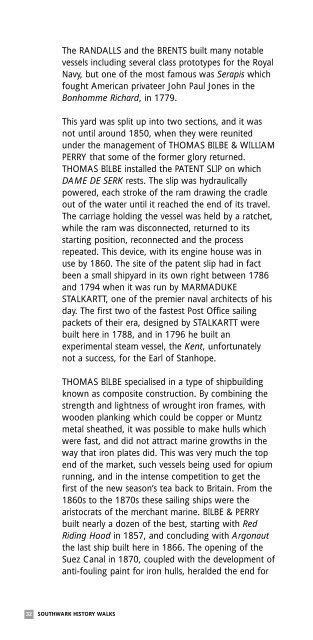Granaries, Shipyards and Wharves - Cycling from Guildford
Granaries, Shipyards and Wharves - Cycling from Guildford
Granaries, Shipyards and Wharves - Cycling from Guildford
You also want an ePaper? Increase the reach of your titles
YUMPU automatically turns print PDFs into web optimized ePapers that Google loves.
The RANDALLS <strong>and</strong> the BRENTS built many notable<br />
vessels including several class prototypes for the Royal<br />
Navy, but one of the most famous was Serapis which<br />
fought American privateer John Paul Jones in the<br />
Bonhomme Richard, in 1779.<br />
This yard was split up into two sections, <strong>and</strong> it was<br />
not until around 1850, when they were reunited<br />
under the management of THOMAS BILBE & WILLIAM<br />
PERRY that some of the former glory returned.<br />
THOMAS BILBE installed the PATENT SLIP on which<br />
DAME DE SERK rests. The slip was hydraulically<br />
powered, each stroke of the ram drawing the cradle<br />
out of the water until it reached the end of its travel.<br />
The carriage holding the vessel was held by a ratchet,<br />
while the ram was disconnected, returned to its<br />
starting position, reconnected <strong>and</strong> the process<br />
repeated. This device, with its engine house was in<br />
use by 1860. The site of the patent slip had in fact<br />
been a small shipyard in its own right between 1786<br />
<strong>and</strong> 1794 when it was run by MARMADUKE<br />
STALKARTT, one of the premier naval architects of his<br />
day. The first two of the fastest Post Office sailing<br />
packets of their era, designed by STALKARTT were<br />
built here in 1788, <strong>and</strong> in 1796 he built an<br />
experimental steam vessel, the Kent, unfortunately<br />
not a success, for the Earl of Stanhope.<br />
THOMAS BILBE specialised in a type of shipbuilding<br />
known as composite construction. By combining the<br />
strength <strong>and</strong> lightness of wrought iron frames, with<br />
wooden planking which could be copper or Muntz<br />
metal sheathed, it was possible to make hulls which<br />
were fast, <strong>and</strong> did not attract marine growths in the<br />
way that iron plates did. This was very much the top<br />
end of the market, such vessels being used for opium<br />
running, <strong>and</strong> in the intense competition to get the<br />
first of the new season’s tea back to Britain. From the<br />
1860s to the 1870s these sailing ships were the<br />
aristocrats of the merchant marine. BILBE & PERRY<br />
built nearly a dozen of the best, starting with Red<br />
Riding Hood in 1857, <strong>and</strong> concluding with Argonaut<br />
the last ship built here in 1866. The opening of the<br />
Suez Canal in 1870, coupled with the development of<br />
anti-fouling paint for iron hulls, heralded the end for<br />
32 SOUTHWARK HISTORY WALKS


